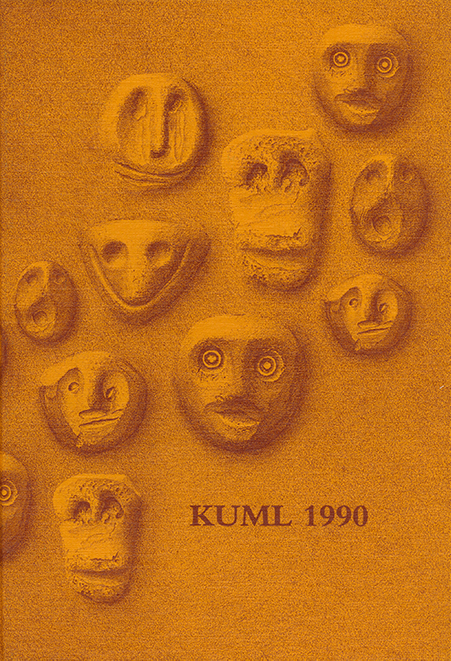Stentinget. An inland site with trade and handicrafts from the later Iron Age. A preliminary notice
DOI:
https://doi.org/10.7146/kuml.v37i37.111172Keywords:
Stentinget, inland site, trade, handicrafts, late iron age, viking ageAbstract
Stentinget
An inland site with trade and handicrafts from the later Iron Age
A preliminary notice
Objects found with metal detector disclosed in 1989 a large inland settlement from the Germanic and Viking periods in Vendsyssel. The site, which is given the name Stentinget (1), lies in the SE part of Vendsyssel a little north of the village of Klokkerholm on the west side of the Jutland ridge (fig. 1). The site covers an area of about half a km' on the top and western and southern slopes of a pronounced morainic prominence whence there is a view in all directions. Immediately W of Stentinget is extensive wetland from the eastern ramifications of Ry å watercourse. The overland distances to the east coast and to the Limfjord are about 18 km. The distance to Limfjorden by way of Ry å is 52 km.
About 350 metal objects have been found by detector at Stentinget, ranging in time from the early Roman Iron Age to late Viking times, but the majority are from 600-1100 A.D. Most are ornaments or fragments of ornaments. Many are gilded or silvered, a few have inlays of red enamel, niello, or stone. Of particular note are the following: -a plate fibula with red enamel inlay (fig. 6, no. 6), for parallel see (2); animal mask from a relief fibula with niello and inlaid stone (fig. 3 no. 2); gilded tortoise brooch with originally ca. 13 inlaid stones (fig. 3 no. 1); a gilded fibula with mythical figures (fig. 6 no. 1) (3); and the birdshaped fibula (fig. 6 no. 4). The strap/belt equipment includes one of Denmark's finest belt terminals. It is Frankish and of solid silver with gilded leaf decoration on the front and niello plant interlace on the back. Twenty weights have also been found, and 8 coins, which were made up by 2 Roman denarii, 4 Arabic silver coins, and a Saxon and a German 11th century coin (4). Some other finds also deserve mention. There is a little goldfoil figure (fig. 3 no. 3) (5), a Thor's hammer and cross of lead (fig. 8 no. 1-2), and keys of bronze (fig. 8 no. 6-9).
In 1990 Vendsyssel Historical Museum began the first trial excavations. At the centre of the settlement near the highest point there were found fence remains, 13 pit huts (two of which were smithies), parts of a long house, and other features. They can be dated to the later Germanic Iron Age and Viking period (fig. 9). In the SW part of the area were found five inhumation burials from Viking times, which probably are part of a larger cemetery (fig. 11 and 12).
The siting and extent of the settlement, the evidence of trading and craft production, and the number and sometimes quality of the finds suggests that in 600-1000 A.D. the site played an important economic, and therefore important political role in the region.
The place-name Byrhøj, now given to the highest point, can be explained as originally »Bygharhøgh« - i.e. »bygdhøj« or »bygdens høj« (6). »Stentinget« is the name of a local townland and of its only farm, but originally, before the townland was brought into existence it was the name of a barrow that in 1769 was called »Steen Tinget« (7). The name may indicate that also a ting was attached to the settlement.
Adam of Bremen in his Descriptio Insularum Aquilonis, book 4, chapter 2, mentions a number of bishoprics -»The archbishop then appointed Oddo in Ribe, Krestian in Århus, Heribert in Viborg, and Magnus in Vendsyssel«. Vendsyssel is here probably a town name, and it sometimes appears as such on maps of Denmark far into historical times. This is interesting, as the town »Vendsyssel« on the old maps is shown approximately at Stentinget's position. In his description in Atlas Danicus Peder Hansen Resens remarks that the town of Vendsyssel may once have been the leading town of the province (8).
Although place names and historical sources only provide an uncertain basis, they ought still to be taken into account when evaluating the archaeological remains at Stentinget.
Torben Nilsson
Downloads
Published
How to Cite
Issue
Section
License
Fra og med årgang 2022 er artikler udgivet i Kuml med en licens fra Creative Commons (CC BY-NC-SA 4.0).
Alle tidligere årgange af tidsskriftet er ikke udgivet med en licens fra Creative Commons.


